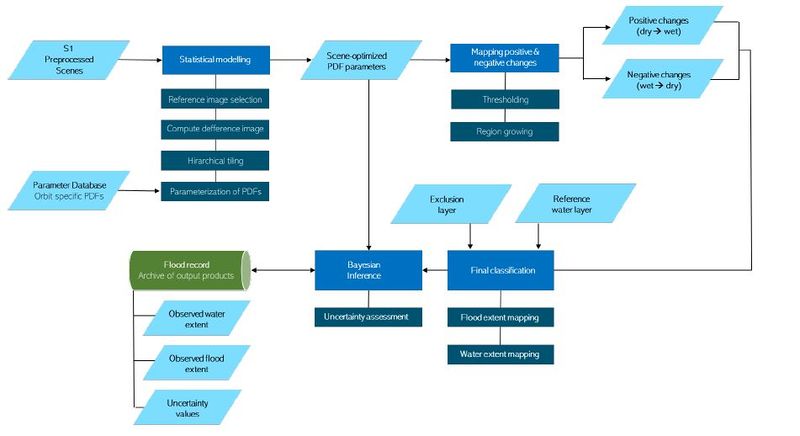HASARD
HASARD is a probabilistic flood mapping algorithm developed by LIST based on Bayesian inference.
Following the procedure introduced in Giustarini et al. (2016) [1] the probability of each pixel in any newly acquired SAR image being flooded given its measured backscatter value is estimated in near-real time.
The approach is based on the two distribution functions of backscatter values attributed to flooded and non-flooded terrain in the area covered by the image.
The procedure to calibrate the four parameters of the Gaussian probability distribution functions (PDFs) based on the histograms of every newly acquired SAR image is explained in detail in Chini et al. (2017)[2].
When the parameters of the PDFs are known, the conditional probability of a pixel being flooded given its backscatter value can be derived using Bayes’ theorem.
Its computation, thus, requires both the probability distributions of backscatter values of flooded and non-flooded pixels and the prior probabilities of a pixel being flooded and non-flooded.
In the Bayesian framework, the prior probability p(F) of a pixel being flooded corresponds to the probability of it being flooded prior to the backscatter value being measured.
In principle, for a given pixel, any information other than the backscatter value of the pixel itself, σ0, can be used to estimate these prior probabilities.
However, when no such ancillary data is available, the simplest choice is to use a non-informative prior, where p(F) = 0.5, and where flooded and non-flooded pixels are equally likely a priori.
Findings in Giustarini et al. (2016)[1] showed that the non-informative prior leads to acceptable performance in terms of reliability and little is to be gained by attempting to estimate prior probabilities from other sources of data.
The non-informative priori is, thus, considered an acceptable choice, especially in the absence of any other exploitable data. It also worth mentioning that Bayesian inference is applied independently to each pixel, regardless of its spatial location.
Preliminary masking with the exclusion layer and the reference water extent layer is undertaken so that no probabilities are computed for those areas.
Probability map values range from 0 and 1.
Workflow of the algorithm
In a nutshell
HASARD is based on a scientifically validated and patented technology enabling a systematic, automatic and high-accuracy monitoring of water bodies using Sentinel-1 data. The algorithm uses a highly innovative sequence of hierarchical image splitting, statistical modelling and region growing to delineate and classify areas that changed their flooding-related backscatter response between two image acquisitions from the same orbits.
For further details the Reader is referred to the dedicated section of the Product Description Document: https://www.gfm_pdd.org/Hasard
References

